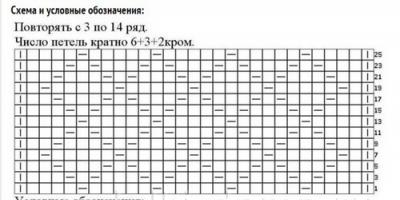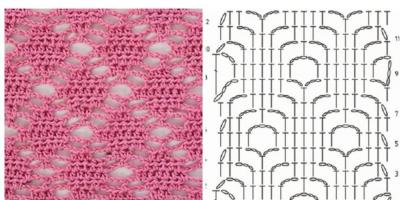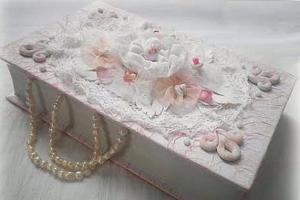So, let's go. We knit this chic top.
The survey was here
Yarn
in my opinion, any will do; adding reports in length and width will not be difficult
I knit with Begonia 169m/50g
Hook
we take a number so that the mating is not loose, the fillet should be clear, even, not loose,
for example, if I were knitting Begonia openwork, I could take 2.5, but for fillet, 1.9 maximum, you can take 1.75
Cross knitting
Original - part width 7 stripes, length - 97 loops
Procedure
1. choose yarn,
we knit a sample - any fillet with a cage of 1 dc and 2 ch,
We select a hook during knitting the sample so that the knitting looks even, clear and beautiful
to see the knitting, cast on at least 40 stitches for the sample (39 stitches in cells, 1 stitch at the end of the row)
2. measure the sample, determine how many loops are in 10cm,
we decide what length of the product you need, we start from this with the number of loops of the cast-on row
3. add 1 diamond = 35 stitches
original length 97 loops
4. start knitting
diagram on 2 sheets, start with diagram 1
take a full-size hook or a number larger than the one we will knit with and cast on a ch chain with the length you chose
1st row - diagram 1. cast on 97 loops, change the hook to the number we will knit with
+8ch, knit dc in the 15th ch of the chain, knit according to the pattern to the end of the row, ending the row with 7dc,
we get 11 ch, turn the knitting to the second row
2nd row - we knit a dc in 9 ch of the typed chain, and another 6 dc in the next loops, we knit according to the pattern until the end of the row, finish the row with 4 dc
3rd row - 3ch rise = first dc and another 6dc, knit to the end of the row according to the pattern, at the end of the row 7dc, pick up 11ch, turn
take a piece of thread from another ball, attach the thread to the top third ch started third row, knit a chain of 18 ch, close the chain, cut the thread
4th row - in 9ch, knit a dc and another 6dc, knit according to the pattern until the end of the row - the end of the row is 7dc, 2ch, 1dc - the row is over,
now we still knit the 4th row along the chain that we added additionally -
main thread 2 ch, half double crochet in 3 ch of additional chain
2vp, connection art. in 6ch of an additional chain, i.e. skip 2p of chains and tie in 3
5th row - along the additional chain we make 5 stitches, turn the knitting
ch - 2 half double crochets - 6dc, then follow the pattern to the end of the row at the end of the row 7dc
6th row - 3ch of rise and 2ch of the beginning of the row, dc in 4dc of the previous row, knit according to the pattern until the end of the row
end of the row - 7dc - 5 cells from 2ch and dc,
2ch - half double crochet in 3ch additional chain,
2ch, connect st to the last ch of the additional chain - all additional chains are over
With the main thread we knit 47 ch and in the 9th ch of this chain dc and another 3 dc = we start knitting the 7th row, this is the strap row
My process, at the moment the entire front is already knitted, I moved to the back, I knit with a single fabric, but more on that later
Many of you have thin threads, so a length of 97 loops may not be enough
my top lengthening options
A) add diamond(s) to the length
b) add another row of zig-zag at the bottom
C) lengthen the body of the top, starting the armhole higher not by the whole diamond, but by part of it, and accordingly, then lengthen the strap too
The first 2 options are simple and do not require additional explanations
and for those for whom 97 loops are not enough, but a whole diamond is a lot, option B is suitable
Here are some explanations for you.
Can be extended by any number of loops, our diagram 1,
the red line marks an extension of 18 loops,
This is how long the body of the top will be up to the armhole, look at the green line
cast on row 122 loops + 8 loops, turn, tie dc into 15 loops of the chain
look at diagram 1, find along the green line the 9th row of the entire knitting or the 3rd row of straps = this is the place where your knitting starts from the 1st row
1 row of armhole = 4 row of knitting
- knitted 4 dc, knit along the chain dc, 2 double crochets 2 ch, connect st through 2 st in 3 chains, 5 join st along the chain, turn,
5 row of knitting = 2 row of armhole
5ch, dc in the connecting column, the cat was after 2ch before the row (see the line above) and another 6 dc in each loop = 7 dc they will be just above the last dc of 4 rows when you attached the chain, then 3 windows, 13 dc, etc. according to the pattern until the end of the row
Last = 3rd row of armhole = 6th row of knitting
goes 7dc, 5ch 3dc along the air loops before the row, we knit the next ones along the chain = 3dc, 2 half double crochets, sc, connect st in the last loop of the chain
The whole chain is over, cast on 42 loops for the strap with the main thread or as many as needed, a multiple of 3, look at which stitch should be first and knit the strap
Girls, this is the principle of how to lengthen it, it doesn’t mean that I will count for everyone, otherwise I will spend the night in SM, showing how it can be done, according to this principle, you can also calculate for your number
GIRLS who finish tying before
I knit the back at once, not as a separate piece, there is no point in separating
PLEASE NOTE that row 1 and row 57 are rows of stops for diamonds
this means that you knit the back from the 2nd row of the pattern and end with the 56th row, joining, in the process of knitting the 56th row, to the first row of the front
A hook is a convenient knitting tool that allows you to create amazingly beautiful patterns. Even novice craftsmen, armed with detailed diagrams and clear descriptions, can easily create amazing canvases with floral, geometric or fantasy patterns. In this article we will share beautiful patterns of openwork diamonds, crocheted, and provide detailed descriptions of the work process for beginners in knitting. Using our patterns, you can learn how to create unique products - cozy autumn shawls, scarves, cardigans.
Beautiful pattern "Rhombuses" for beginner knitters
This simple and at the same time interesting and stylish pattern is perfect for making a stole, dress or scarf. Beginning needlewomen will be able to crochet diamonds. All that is required is to prepare the necessary tools for the work, yarn and first learn how to perform a chain loop, half double crochet and double crochet. It is the use of these simple elements that will allow you to obtain a non-trivial crochet pattern - “Rhombuses”.
Let's use a sample example to learn how to do it. Let's knit an initial chain of 18 chain stitches. In the first row we make 5 air loops (VP), 7 half double crochets (DSN), 5 VP. We skip two base loops and make 7 PPSN in the next one. Next we knit 2 VP. We skip 1 initial loop and perform 1 double crochet (C1H).
In row No. 2 we knit 4 VP, 5 PPSN (in 5 central loops of seven half-columns of the previous row), 3 VP, 1 PPSN in an arch of 5 loops, again 3 VP and 5 PPSN. We finish with 3 VPs and one half-column. We perform the last element in the third loop of the initial chain of the bottom row.
In the third row we create 1 VP, 1 PPSN in the first loop of the previous row, 3 PPSN (in the central loops of the group of 5 PPSN of the bottom row), 3 VP. Next, we create 3 PPSN again. Please note that we knit the central one into the half-column loop of the previous row, and the other two into adjacent arches. Now we perform 3 VP, 3 PPSN (in the three central loops of 5 half-columns of the previous row), 3 VP and 2 PPSN (in the last 2 loops).

We continue to knit the sample
We continue to learn how to crochet a diamond. The description of the fourth row of the diagram is as follows. At the beginning we make 1 VP, 2 PPSN, 3 VP and 1 PPSN (in the central loop of three half-columns of row No. 3). Next, we knit 3 VP and 5 PPSN, three of which are in the loops of the underlying half-columns, and the others in adjacent arches. We perform 3 VP, 1 PPSN (in the central half-column from the group of the previous row), 3 VP and 3 PPSN.
In the fifth row we make 1 VP, 3 PPSN, 5 VP, 7 PPSN (five of them in the PPSN loops, the rest in adjacent arches), 5 VP, 4 PPSN. We hope you haven’t encountered any difficulties in creating crochet diamonds yet? Let's continue working!
We knit the sixth row according to the following pattern: 1 VP, 2 PPSN, 3 VP, 1 PPSN (in the central loop of five elements of the bottom row), 3 VP, 5 PPSN (in five central half-columns of seven), 3 VP, 1 PPSN, 3 VP, 3 PPSN.
Row No. 7 is done like this: 1 VP, 1 PPSN, 3 VP, 3 PPSN (the central one in the half-column loop of the previous row, and the rest in the adjacent arches). Next 3 VP, 3 PPSN (in three central loops of five half-columns), 3 VP, 3 PPSN (middle one in the loop of a half-column of the previous row, the other two - in adjacent chains), 3 VP, 2 PPSN.
Let's finish the job. Crochet pattern "Rhombus" is almost ready
Row eight: 4 VP, 5 PPSN (three of them in three loops of half-columns, two in arches), 3 VP, 1 PPSN (in the central loop from 3 PPSN of the previous row), 3 VP, 5 PPSN (three in three loops half-columns, two in arches), 3 VP, 1 PPSN in a chain of VP. The sample is almost finished.
Next, we repeat the pattern of rows, that is, we knit the tenth by analogy with the second, the eleventh with the third, etc. As a result, we get a beautiful, openwork crocheted fabric. The rhombuses in the pattern form a harmonious pattern. Be sure to learn how to knit using this pattern; in the future you will be able to use it to create original stoles, bacti or scarves.

Another good pattern with openwork rhombuses
How nice it is to wrap yourself in a warm, soft shawl made by yourself in the autumn cold! It will warm its owner and bring aesthetic pleasure thanks to its laconic and stylish pattern.
To create such a shawl you will need Alpaca Royal Alize yarn with a density of 100 g per 250 m. It is soft and warm, excellent for autumn clothes due to the content of alpaca wool. You will also need a hook for 3 and scissors. We will work according to the following scheme.

Knitting an autumn shawl
We will create the pattern of the product using chains of 5 chain loops and groups of 5 double crochets. It's actually quite easy to do. The main thing is to stick to the pattern, moving from bottom to top and turning the product.
In the first row we knit 3 VP and 4 double crochets (C1H), leaving two loops. In the second row - first 3 VP, 4 C1H, single crochet (SC) and a group of 5 C1H. Row number three starts with three VPs and 4 C1H, then we knit 1 RLS (in the third column from the end of the previous row), a chain of 5 VPs, again 1 RLS. We finish with a group of 5 C1H. We continue to knit the shawl according to the pattern, using arches from VP and groups of posts, to the required size of the product. As a result, you will get a cozy, beautiful and warm stole with a “Rhombus” crochet pattern. I wish you creative success!
Hello everyone, friends!
I come to you with beautiful ideas for blankets and pillows made from diamond-shaped motifs. It’s very easy to crochet diamonds, even beginners can do it, I’ll give you diagrams and descriptions. And depending on the color and arrangement of motifs, sometimes very original things are obtained, even with a 3D effect.
For inspiration, let's look at a small selection of diamond blanket ideas.
Crochet diamond blankets
Video
The basis for knitting such blankets is the crochet rhombus motif. They can be knitted from all sorts of threads, and if you buy new threads, I recommend Alize or Kamtex yarn (wool with acrylic). The consumption for a large blanket is approximately about 3 kilograms. We select the hook accordingly.
It is best to tie finished blankets with single crochets and it is not at all necessary to come up with some kind of border.
Crochet tight rhombus

Most of these beautiful blankets from the video are crocheted from simple dense diamonds: the diagram is in front of you. True, it is somewhat incorrect: they forgot to draw air loops at the beginning of each row instead of the first columns (see the second diagram).

I'm telling you how to crochet a diamond.
Crochet diamond: knitting description
We start knitting the motif from the bottom and knit upwards in turning rows. We cast on one loop and from it in the first row we knit two stitches with one crochet (instead of the first - 3 VP).
Then we begin to decrease the loops: at the beginning and end of each row we knit two unfinished double crochets, knitted together, and instead of the first we cast on 2 VPs.
To create a blanket, you will also need motifs from halves of rhombuses; we knit some of them with increases on the left and right until the middle of the pattern and finish knitting. When knitting other increases and decreases, we perform them only on the left side (or on the right), and knit the other side evenly.
Connection of motives
To combine all the motifs into a plaid, you need to tie each diamond around the perimeter with single crochets; you can use a thread of the same color, different from the color of the diamonds.
Then we fold them together one by one and connect them with a hook along the wrong side using connecting loops at the back walls.
Crochet rhombus with openwork pattern

An even more spectacular crochet diamond pattern is obtained by knitting a motif with openwork holes in it, like a sirloin pattern.

Description of knitting
According to the pattern, unlike the previous version of the diamond, you need to knit three double crochets from the first loop.
We perform increases and decreases in the same way.
In the fifth row, knitting 5 double crochets, in the central part, instead of a stitch, we knit one air loop.
And so we will have 5 columns along the edges, and an openwork pattern in the center.
In the sixth row: 5С1Н, 1ВП, 1С1Н, 1ВП, 5С1Н.
In the seventh: 5С1Н, 1ВП, 3С1Н, 1ВП, 5С1Н.
In the eighth: 5С1Н, 1ВП, 5С1Н, 1ВП, 5С1Н.
In the ninth: 5С1Н, 1ВП, 7С1Н, 1ВП, 5С1Н.
In the tenth: 5С1Н, 1ВП, 9С1Н, 1ВП, 5С1Н.
In the eleventh: 5С1Н, 1ВП, 5С1Н, 1ВП, 5С1Н, 1ВП, 5С1Н.
In the twelfth: 5С1Н, 1ВП, 5С1Н, 1ВП, 1С1Н, 1ВП, 5С1Н, 1ВП, 5С1Н.
In the thirteenth: 5С1Н, 1ВП, 5С1Н, 1ВП, 3С1Н, 1ВП, 5С1Н, 1ВП, 5С1Н.
From the fourteenth row we knit in reverse order in a mirror image.
Openwork crochet rhombus from the center

For a sample, just to understand the openwork diamond pattern, I knitted in one color, but if you change the threads in the rows, we get the effect of peacock feathers on the blanket. I think this blanket is called that way.

Description of knitting
In this case, we knit the motif in the round, starting from the center.
In a sliding loop: 6 times 3C1H, knitted together, and 3VP.
Row 2: Form the sides of the diamond. If you look at the diagram, we see that on two sides under the arches of air loops we knit 4С1Н, and under the lower and upper arches we knit 4С1Н, 7ВП, 4С1Н.
Row 3: in each column we knit a double crochet, while in the central two loops on the left and two loops on the right - two double crochets. Under the arches: 4С1Н, 7ВП, 4С1Н.
Row 4: similar to row 3, but in the central two loops on the sides - three double crochets.
Row 5: arches from 3VP, connecting them with a single crochet in every 4th loop. In the lower and upper arches: 3VP, 1СБН, 1ВП, 1СБН, 3ВП.
You need to connect the motifs in the process of knitting for the arches: 1VP, a column under the arch of the second motif, 1VP.
Small crochet diamond

And another blanket model is made like a mosaic of small motifs. Real crocheted patchwork! These diamonds are very similar to the previous ones. It is recommended to connect them immediately during the knitting process, starting from the middle part of the blanket: knit several diamonds of the desired color - sew them together, then knit and attach another fragment.

Description of knitting
In a sliding loop: 1СБН, 1 incomplete double crochet, 1С1Н, 1С2Н, 3VP, 1С2Н, 1С1Н, 1С1Н and again the same combination.
Row 2: in each column - double crochet, while on the sides in the sc of the previous row: 1С1Н, 2ВП, 1С1Н. And in the lower and upper arches: 3С1Н, 4ВП, 3С1Н.
Openwork diamonds are a simple crochet pattern that beginner knitters can do. When knitting, single crochets and air loops are used. It is easier to knit this pattern according to the pattern. The description is tediously long. For a sample pattern, cast on a chain of chain stitches in a number that is a multiple of 9 plus 5 stitches.
1 row : skip 5 chain loops, * 7 single crochet, 5 chain loops, skip 2 chain loops *, 7 single crochet, 2 chain loops, skip 1 loop on the chain, double crochet in the last loop of the chain;
2nd row: 4 chain stitches, * 5 single crochet stitches in the loops of 5 central chain stitches from the 7 stitches of the previous row, 3 chain stitches, 1 single crochet stitch in the central chain stitch from the 5th previous row, 3 chain stitches *, 5 single crochet stitches double crochet in the 5 center loops of the 7 stitches of the previous row, 3 chain stitches, 1 single crochet in the 3rd chain stitch of the previous row;
3rd row : 1 chain stitch, 1 double crochet in the 1st chain crochet of the previous row, * 3 single crochets in the loops of 3 central of the 5 stitches of the previous row, 3 chain loops, 3 single crochets (the central one in single crochet loop of the previous row and 2 in the adjacent chain stitches), 3 chain stitches *, 3 single crochet stitches in the loops of the 3 central of the 5 stitches of the previous row, 3 chain stitches, 2 single crochet stitches in the last 2 chain stitches previous row;
4th row: 1 chain stitch, 2 single crochets, * 3 chain stitches, 1 single crochet in the loop of the center of the 3 stitches of the previous row, 3 chain loops, 5 single crochets (3 of them in the loops of 3 stitches of the previous row and 2 in adjacent chain stitches) *, 3 chain stitches, 1 single crochet in the central loop of the 3 stitches of the previous row, 3 chain stitches, 3 single crochet;
5 row : 1 chain stitch, 3 single crochet stitches, * 5 chain stitches, 7 single crochet stitches (5 of them in the loops of the 5 stitches of the previous row and 2 in the adjacent chain stitches), 5 chain loops, 4 single crochet stitches;
6 row : 1 chain stitch, 2 single crochet stitches, * 3 chain stitches, 1 single crochet stitch in the central chain stitch from the 5th previous row, 3 chain stitches, 5 single crochet stitches in the loops of the 5 central chain stitches from the previous 7 stitches row *, 3 chain stitches, 1 single crochet in the central chain stitch from the 5th previous row, 3 chain stitches, 3 single crochet;
7 row : 1 chain stitch, 1 double crochet, * 3 chain stitches, 3 single crochet stitches (the central one in the single crochet loop of the previous row and 2 in the adjacent chain stitches), 3 chain stitches, 3 single crochet stitches in 3- x central of 5 stitches of the previous row *, 3 chain stitches, 3 single crochet stitches (the central one in the single crochet loop of the previous row and 2 in the adjacent chain stitches), 3 chain stitches, 2 single crochet stitches;
8 row : 4 chain stitches, * 5 single crochets (3 of them in the loops of 3 stitches of the previous row and 2 in adjacent chain loops), 3 chain stitches, 1 single crochet in the loop of the central of the 3 stitches of the previous row, 3 chain stitches *, 5 single crochets (3 of them in the loops of 3 stitches of the previous row and 2 in adjacent chain loops), 3 chain stitches, 1 single crochet in the chain stitch of the previous row;
9 row : 6 chain stitches, * 7 single crochet stitches (5 of them in the loops of 5 stitches of the previous row and 2 in adjacent chain stitches), 5 chain stitches *, 7 single crochet stitches (5 of them in the loops of 5 stitches of the previous row row and 2 in adjacent chain stitches), 2 chain stitches, 1 double crochet in the outermost chain stitch of the previous row.
The pattern is repeated from the 2nd row.
Crochet pattern
 |
Symbols for the crochet pattern
|
Air loop. |








